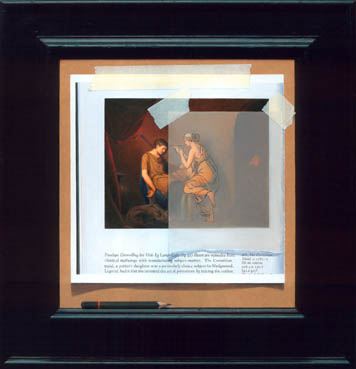 |
||||
|
Tracing (2006) Oil on board, 26x24cm (excluding frame) Private collection |
||||
|
A Note on Tracing In my painting 'Tracing', I made a very literal re-presentation of Pliny's myth of the origin of painting. The image being traced in this picture is a reproduction of 'The Corinthian Maid', c.1782-5, by Joseph Wright of Derby, which shows the eponymous maid, the daughter of a potter, tracing in slip the shadow of her sleeping lover on the eve of his leaving for war. This was a commission for Josiah Wedgwood, the subject having a special resonance for him, relating as it did to both his industry and his aesthetics. In 'Burning With Desire: the Conception of Photography', Geoffrey Batchen used Wright's painting as a fulcrum for a discussion around the speculative motivations for how Wedgwood's son Thomas came to make experiments with Humphrey Davy in photography around 1800. Batchen's book includes Thomas Wedgwood and Davy in his list of 'proto-photographers': thirty years before Daguerre and Fox Talbot, they created images in silver nitrate on leather and paper, but were unable to fix them. 'Burning with Desire' describes how, despite both the optical and chemical bases for photography being known by the middle of the eighteenth century, there was still the need for the concept of photography to come about before it could be realised. Batchen quotes Victor Burgin (an artist who has also used the myth of the origin of painting) who argues that "the origin of photography is identical with the origin of painting, with the origin of any desire for the image," and in doing so explicitly links his father's commissioning of the painting by Wright to Thomas' later striving for the photographic image. Sources ©copyright 2018 Nicholas Middleton |
||||